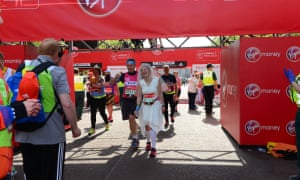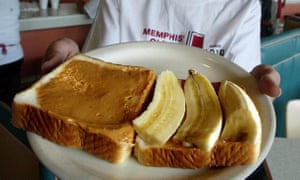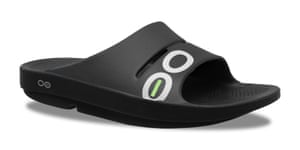Congratulations! You are a marathoner. For months, you’ve focused on that one goal – had nightmares about it, over-analysed every niggle and spent sleepless nights fretting about what shoes to wear. Well, now you’ve gone and done it. The box is ticked, the medal is hanging around your neck. So, what now?
The chances are that having pored over every minute decision that went into running the race, you’ve given absolutely no thought to how to recover from it: you certainly won’t be alone. But if you want to recover in good speed, and get back out there – either to train for another marathon or just stop feeling like a bus hit you – then you should. Treat the recovery the same way as you did the training – as an integral part of the marathon process, and you’ll soon be back and raring to go. Get back too soon and push too early, and you risk injury.

Immediately after the race
The second you cross that line, your legs will go from running to “utterly incapable of movement”. But don’t stop. The best thing you can do is just keep moving – it doesn’t matter how slowly. Get into clean, dry clothes and comfy shoes: I’ll be staggering around slowly in Oofos slides, others swear by cheap flip-flops. Whatever you find comfortable. If you are a fan of compression gear, now is also the time to get into that (a challenge in itself, when it comes to climbing into those tights … ). While the jury is out on the benefits of actually running in compression gear, it can definitely help aid recovery. Go for proper, quality compression like those from CEP. It’s one area where cheap options can be a false economy.
If you have any very specific sore spots, noticeable immediately, you can try a topical product like a ‘freezing’ spray. Chris Roberts, a rehabilitation therapist, explains: “Cryotherapy products such as Biofreeze are topical analgesics, which work through a ‘counter-irritant’ mechanism. This creates a sensation that overrides pain signals to the brain. This process is known as ‘gate control theory’, where nerve impulses from one stimulus block the nerves containing pain signals to the brain. But it is important to remember that cryotherapy only provides temporary pain relief and is not a long-term solution if injury does occur.”
A note on painkillers: please, please, think twice. NSAIDs – such as ibuprofen or aspirin – are a lot stronger than many people realise. No one wants to be in pain, but you also don’t want to mask injury and risk making it worse. Nor do you want to do damage to a body that’s just gone through quite an ordeal. NSAIDS can cause harm to your kidneys, which are already working overtime, given you are undoubtedly mildly dehydrated, at best, and increase your blood pressure to risky levels, as well as putting you at greater risk for hyponatremia.

Eat something
You can research, endlessly, the latest research into the right balance of protein vs carbs and the crucial post-race recovery window in which to eat them. And in an ideal world, you’ll have that three-parts carbs/one-part protein snack waiting for you. However … I’ve run 10 marathons and I know full well that sometimes you can’t even look at food after the race. You’ve just run 26.2 miles and your stomach is queasy, full of gels and in rebellion. Don’t worry, just try and eat whatever you can cope with, whether that’s an ice cream, a bag of crisps, a banana or a protein bar. Have a proper good meal later: heaven knows you’ve earned it. Or celebrate the next day when you feel up to it. Do, however, make sure you rehydrate – take the water you’ll be offered at the finish and keep sipping away for the rest of the day.

Hot vs cold
Back in the comfort of your home or hotel room, it’s time to soak those aching limbs. So what’s better, hot or cold? “The research is ever changing in this area,” says Neil Smith, a physiotherapist at Pure Sports Medicine. “But I would say that ice baths are likely to be better for recovery than a hot bath. It may not be the first thing you want to inflict on yourself after 26.2 gruelling miles – but it does have some positive effects – including reducing Doms (delayed onset muscle soreness). However, if you really feel like a dip in a hot bath the evening of the marathon then no one is going to stop you!”
Also note that you do not need access to a fancy cryogenic chamber: “How cold it should be is definitely a personal choice – but something in the region of 15C would work” says Smith. “Some athletes like to go as low as 8C – and that is still achievable with cold water and plenty of bags of ice.”
However, Smith and his colleague Lisa Posnett are sceptical that Epsom salts, which are often recommended as a post-marathon remedy, make any difference. “Epsom salt is a common name for magnesium sulphate,” they say. “Despite it being used for decades, there is actually little evidence out there to support its use and muscle soreness alleviation. The idea behind it is it helps reduce magnesium deficiency. However, if it seems to work for you – even if it just provides a placebo effect – then go for it!”

Massage
Many races will offer you a quick post-race massage. That can definitely help, but can also involve standing around in a queue, which itself can be a form of post-race torture. But if you can afford it, a proper sports massage is a really good idea. As Ellen Cook, sports massage therapist at Ten Health and Fitness says: “The sooner you can do this, the better, as it will flush out any lactic acid that has built up during the race and in turn reduce the build-up of muscle tension. Pushing ourselves that far can cause damage to the muscles. Sports massages help by warming up the muscle fibres through friction and improves blood flow and circulation. Once the muscles are warm they become more malleable, making it easier to release tension, re-align them and ultimately speeding up the healing process.”
And if you’ve had a Torquemada-like experience, then don’t be put off. “There are many myths out there regarding sports massage,” says Cook. “The most common is that effective massage should hurt. This is not correct at all, there are many techniques for massage that are used to relieve muscle tension and sometimes going gung-ho on a muscle is not what it needs.” So don’t be afraid to ask your masseur to back off a bit: there are no prizes for enduring agony.

Sleep well – but don’t worry if you don’t
Sleep is essential for recovery. However, this also comes under the “great idea in theory, hard in practice” rule. I have never slept well after a marathon. You are riding an adrenaline high (or, though I hope not, a crashing low) and every muscle in your legs is twitching and your system just can’t seem to shut down. Don’t worry – this is perfectly normal. Just rest. Don’t reach for the phone, just try to relax, listen to an audiobook, have another bath … whatever helps you to drift off again. You’ll no doubt catch up and sleep like a log on subsequent nights.

Look after your feet
If you have a blister or two, leave them alone. As Neil Smith at Pure Sports Medicine says: “If the blister hasn’t popped on its own then don’t pop it yourself. Cover it with a soft plaster – there are some great blister plasters available these days. If it has burst already – let it drain, clean it, then cover it to help prevent infection. Also avoid wearing tight-fitting shoes [after the race] that may further irritate.” In fact, comfy shoes for a few days after the race are a good idea for everyone, regardless of blisters.

Doms vs Injury
If your legs don’t feel like they fought a war the next day – and the day after that – then did you really run that marathon? But at what point do you know if it’s just a sore muscle, or something worse. “Doms can start a few hours after your exercise and will often peak at about 48-72 hrs, but can last up to even a week,” says Smith. “A lot of people find some gentle massaging and stretching can be helpful. If the pain lasts longer than a week or gets worse then I would suggest seeking some medical advice from a physio or doctor.”
Consider taking a week – or even two – off
To some of you, that will be a no-brainer. Those legs are barely coping with stairs, let alone the idea of running again any time soon. Others, riding an adrenaline high, will be twitching to get back out there again after a few days. Don’t. You have nothing to gain, and a lot of torn muscle fibres that need to heal. If you crave being active, go for a swim, or do a gentle yoga class, but do not feel guilty about not doing any exercise if you don’t feel like it. Remember that elite athletes take a minimum of two very, very easy weeks to recover from a marathon, some longer. If you just want to get outside, gentle walking is a great way to stretch out sore legs.
Post-marathon bugs and blues
Your immune system, as well as your legs, has just taken a battering. Many people come down with a minor bug in the week after a marathon. So look after yourself, and try to eat healthily. Sure, you deserve celebratory treats, but your body needs to rebuild so be nice to it, and give it the micronutrients it deserves. As well as the cake. But don’t be surprised if elation soon turns to a touch of the blues. You’ve spent months planning and training for this event, and suddenly there’s a hole. Start thinking to the future: while you need to rest and recover, there’s no harm in starting to think of your next challenge.
Push on
Follow all this advice (and if you have, you’re doing better than me. As my mum would say: “Do as I say, not as I do”) and you’ll soon – but not too soon – be back and raring to go. Use that marathon fitness and see what it can do to your 5k or 10k times.
Source: Read Full Article
